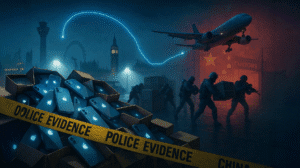by: The Washington Eye
As summer 2025 unfolds, much of the United States is under a blanket—not of warmth, but of atmospheric turbulence caused by two very different natural forces. From the smoky pine forests of central Canada to the parched deserts of North Africa, plumes of wildfire smoke and Saharan dust have converged in American skies, creating a unique cocktail of pollution that’s triggering air quality alerts, disrupting daily life, and raising deeper concerns about climate volatility and public health.
What makes this episode remarkable is not simply its scale, but the scientific oddity of it: two transboundary air pollution events, originating continents apart, arriving almost simultaneously in the continental U.S. The result is a complex, dynamic interaction of fine particulates—PM2.5 from Canadian wildfires and mineral-rich dust from the Sahara—affecting everything from visibility on the roads to emergency room admissions for respiratory distress.
Canadian Wildfires: North America’s Relentless Burner
Canada’s wildfire season has been ferocious. As of early June, more than 200 wildfires are burning across provinces such as Manitoba, Saskatchewan, Alberta, and even as far east as Quebec. Over 4.7 million acres have already been scorched, and the fire season shows no signs of relenting. The intense fires are fueled by a potent mix of dry conditions, higher-than-average temperatures, and strong winds—a familiar climate pattern that has been intensifying over the last decade.
Smoke from these fires has blanketed parts of the northern United States, with Minnesota, Wisconsin, and Michigan suffering the worst of the fallout. In Ely, Minnesota, the Air Quality Index (AQI) soared to a hazardous 336—more than six times the EPA’s recommended safe level. Residents have reported a visible orange haze and the distinct acrid odor of burning timber, even indoors.
But it isn’t just the smell that’s cause for concern. Wildfire smoke is a deadly aerosol. The fine particles it carries—primarily PM2.5—are small enough to penetrate deep into the lungs and enter the bloodstream, leading to inflammation, cardiovascular stress, and long-term respiratory diseases. For the elderly, children, and individuals with pre-existing heart or lung conditions, the risks are immediate and profound.
Saharan Dust: Earth’s Great Traveler
While Canada’s wildfires rage to the north, a second, drier threat is arriving on southern winds. Each summer, enormous clouds of Saharan dust—lifted from the deserts of North Africa—travel across the Atlantic Ocean, carried by the trade winds in a high-altitude phenomenon known as the Saharan Air Layer (SAL). This year’s plume is among the thickest seen in recent years.
The dust plume reached the Caribbean in late May and made landfall along the Gulf Coast by early June, casting a milky veil over skies in Texas, Louisiana, and Florida. For residents of Miami and Houston, the result has been surreal: sunsets painted in deep red and orange, visibility cut to half a mile in some places, and itchy throats and eyes for those caught outside.
Scientifically, Saharan dust is fascinating. It contains iron, phosphorus, and other minerals that fertilize the Amazon rainforest and can suppress hurricanes by introducing dry, stable air into the Atlantic basin. However, once that same dust settles over urban environments, it becomes a health hazard, compounding the respiratory effects of local pollutants and irritating mucous membranes. When it mixes with wildfire smoke, the health consequences are magnified, especially in humid, stagnant air conditions.
A Chemical Collision in the Sky
What makes the current situation particularly dangerous—and scientifically intriguing—is the interaction between the smoke and the dust. Unlike localized pollution events, this dual-source crisis involves two distinct types of particulates with overlapping health effects. While wildfire smoke primarily consists of carbon-based compounds, Saharan dust is mineral-heavy. Combined, they present a multidimensional respiratory hazard.
Meteorologists and atmospheric scientists are now studying how these particles behave when they mix in the troposphere. There’s evidence to suggest that dust particles can act as nuclei for chemical reactions, potentially transforming or enhancing the toxicity of wildfire smoke. In essence, the dust may not only add to the particulate burden—it might chemically alter the very makeup of the smoke in harmful ways.
Additionally, this combination affects climate feedback loops. Both wildfire smoke and dust reflect and absorb sunlight differently. Smoke tends to warm the atmosphere by trapping heat, while dust can cool it by reflecting sunlight back into space. The competing thermal dynamics can disrupt weather patterns, reduce rainfall, and exacerbate drought conditions—ironically feeding the same wildfires that started the cycle.
Public Health and Policy Response
The United States Environmental Protection Agency (EPA), in coordination with local health departments, has issued multi-day air quality alerts across the Midwest and South. Vulnerable populations are urged to stay indoors, run air purifiers, and avoid strenuous activity. In some school districts, outdoor recess has been canceled, and sporting events postponed.
Hospitals in cities like Minneapolis, Chicago, and Houston are reporting modest but notable upticks in asthma-related admissions and complaints of chest tightness and wheezing. The CDC has warned that this summer could be particularly hazardous for those with compromised respiratory systems.
There’s also a growing call for better public preparedness. Climate scientists stress that such dual-pollution events may become more frequent as both wildfires and dust activity increase with global warming. Some municipalities are already exploring subsidized air filtration programs and urban greening initiatives to combat indoor and outdoor air quality decline.
Looking Ahead
Forecasts suggest that the Saharan dust plume will remain over parts of the southeastern U.S. through the coming week, while Canadian wildfires are expected to persist well into July. If wind patterns remain unfavorable, more regions across the U.S.—from the Great Plains to the Eastern Seaboard—could face hazardous air quality.
The scientific community sees this event as a wake-up call. Not just a weather anomaly or a health concern, but a vivid reminder of how interconnected and fragile our atmospheric systems have become. In a year marked by record heat, geopolitical upheaval, and deepening environmental stress, the collision of fire and dust in America’s skies is more than symbolic—it’s a clear warning signal from the planet itself.

















